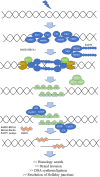Homologous Recombination Deficiency: Cancer Predispositions and Treatment Implications
- PMID: 34021944
- PMCID: PMC8417864
- DOI: 10.1002/onco.13829
Homologous Recombination Deficiency: Cancer Predispositions and Treatment Implications
Abstract
Homologous recombination (HR) is a highly accurate DNA repair mechanism. Several HR genes are established cancer susceptibility genes with clinically actionable pathogenic variants (PVs). Classically, BRCA1 and BRCA2 germline PVs are associated with significant breast and ovarian cancer risks. Patients with BRCA1 or BRCA2 PVs display worse clinical outcomes but respond better to platinum-based chemotherapies and poly-ADP ribose polymerase inhibitors, a trait termed "BRCAness." With the advent of whole-exome sequencing and multigene panels, PVs in other HR genes are increasingly identified among familial cancers. As such, several genes such as PALB2 are reclassified as cancer predisposition genes. But evidence for cancer risks remains unclear for many others. In this review, we will discuss cancer predispositions and treatment implications beyond BRCA1 and BRCA2, with a focus on 24 HR genes: 53BP1, ATM, ATR, ATRIP, BARD1, BLM, BRIP1, DMC1, MRE11A, NBN, PALB2, RAD50, RAD51, RAD51B, RAD51C, RAD51D, RIF1, RMI1, RMI2, RPA1, TOP3A, TOPBP1, XRCC2, and XRCC3. IMPLICATIONS FOR PRACTICE: This review provides a comprehensive reference for readers to quickly identify potential cancer predisposing homologous recombination (HR) genes, and to generate research questions for genes with inconclusive evidence. This review also evaluates the "BRCAness" of each HR member. Clinicians can refer to these discussions to identify potential candidates for future clinical trials.
Keywords: Cancer predisposition; Homologous recombination.
© 2021 AlphaMed Press.
Conflict of interest statement
Figures

Similar articles
-
Pathogenic germline variants in non-BRCA1/2 homologous recombination genes in ovarian cancer: Analysis of tumor phenotype and survival.Gynecol Oncol. 2024 Jan;180:35-43. doi: 10.1016/j.ygyno.2023.11.019. Epub 2023 Dec 1. Gynecol Oncol. 2024. PMID: 38041901 Free PMC article.
-
Associations Between Cancer Predisposition Testing Panel Genes and Breast Cancer.JAMA Oncol. 2017 Sep 1;3(9):1190-1196. doi: 10.1001/jamaoncol.2017.0424. JAMA Oncol. 2017. PMID: 28418444 Free PMC article.
-
Platinum-based chemotherapy for pancreatic cancer: impact of mutations in the homologous recombination repair and Fanconi anemia genes.Ther Adv Med Oncol. 2022 Mar 15;14:17588359221083050. doi: 10.1177/17588359221083050. eCollection 2022. Ther Adv Med Oncol. 2022. PMID: 35309086 Free PMC article.
-
Homologous Recombination Deficiencies and Hereditary Tumors.Int J Mol Sci. 2021 Dec 29;23(1):348. doi: 10.3390/ijms23010348. Int J Mol Sci. 2021. PMID: 35008774 Free PMC article. Review.
-
Recommendations for Preventive Care for Women with Rare Genetic Cause of Breast and Ovarian Cancer.Klin Onkol. 2019 Summer;32(Supplementum2):6-13. doi: 10.14735/amko2019S6. Klin Onkol. 2019. PMID: 31409076 Review. English.
Cited by
-
Impact of additional genetic abnormalities at diagnosis of chronic myeloid leukemia for first-line imatinib-treated patients receiving proactive treatment intervention.Haematologica. 2023 Sep 1;108(9):2380-2395. doi: 10.3324/haematol.2022.282184. Haematologica. 2023. PMID: 36951160 Free PMC article.
-
Double-strand DNA break repair: molecular mechanisms and therapeutic targets.MedComm (2020). 2023 Oct 5;4(5):e388. doi: 10.1002/mco2.388. eCollection 2023 Oct. MedComm (2020). 2023. PMID: 37808268 Free PMC article. Review.
-
Hydroxygenkwanin Increases the Sensitivity of Liver Cancer Cells to Chemotherapy by Inhibiting DNA Damage Response in Mouse Xenograft Models.Int J Mol Sci. 2021 Sep 9;22(18):9766. doi: 10.3390/ijms22189766. Int J Mol Sci. 2021. PMID: 34575923 Free PMC article.
-
Alterations in the expression of homologous recombination repair (HRR) genes in breast cancer tissues considering germline BRCA1/2 mutation status.Breast Cancer Res Treat. 2024 Dec;208(3):501-510. doi: 10.1007/s10549-024-07441-4. Epub 2024 Jul 30. Breast Cancer Res Treat. 2024. PMID: 39080120 Free PMC article.
-
Genomic and transcriptomic profiles associated with response to eribulin and nivolumab combination in HER-2-negative metastatic breast cancer.Cancer Immunol Immunother. 2024 Aug 6;73(10):197. doi: 10.1007/s00262-024-03782-7. Cancer Immunol Immunother. 2024. PMID: 39105849 Free PMC article. Clinical Trial.
References
-
- Ranjha L, Howard SM, Cejka P. Main steps in DNA double‐strand break repair: An introduction to homologous recombination and related processes. Chromosoma 2018;127:187–214. - PubMed
Publication types
MeSH terms
Substances
LinkOut - more resources
Full Text Sources
Other Literature Sources
Medical
Research Materials
Miscellaneous

